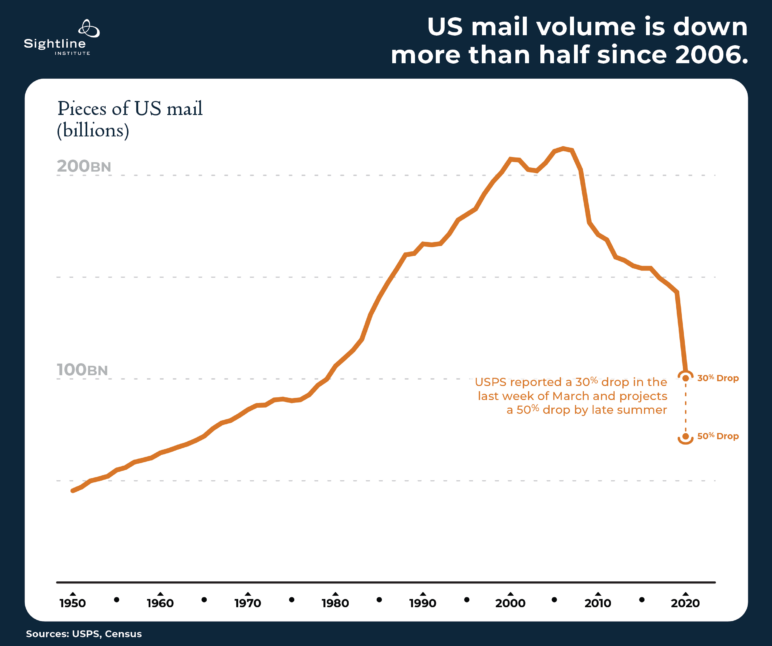In the last installment of this series about things that are already in decline and will—I hope—die or diminish markedly in the pandemic, I made a case against the handshake.
During a pandemic, the US Postal Service (USPS), like Canada Post and its counterparts around the world, is a service as essential as hospitals and grocery stores. USPS delivers letters, ballots, medicine, and packages. Unlike Canada Post and others, however, USPS is careening toward bankruptcy and desperate for a bailout. In the details of this drama may lurk the extinction (or at least a radical diminution) of junk mail, even if USPS is reborn with a more-reliable revenue model (as I hope it will be).
Junk mail isn’t a major-league threat to anyone, but ecologically, it’s more than a nuisance. At last tally, direct-mail advertising single-handedly accounted for approximately 2 percent of US municipal solid waste, and larger environmental costs lie upstream in the production of all that paper. A lot of trees fall, oil burns, and industrial inks are synthesized to print and deliver tens of billions of unsolicited sales pitches per year to mailboxes in the United States.
A lot of trees fall, oil burns, and industrial inks are synthesized to print and deliver tens of billions of unsolicited sales pitches per year to mailboxes in the United States.

Worse, almost none of it even gets read; more than 95 percent of ad mail goes straight into the trash (or—let’s hope—the recycling bin). This combination of economic and ecological wastefulness is why a Do Not Mail Registry is such a good idea (and the political difficulty of winning such a registry is one reason I’ve been on a crusade to eliminate ads from my mailbox for more than a decade).
But while policy change has proved elusive, economic forces are decimating junk mail (which is rather ironic, since they had created it in the first place). Advertising mail drove the explosion of USPS deliveries starting in the late 1970s, as shown in the figure. The chart also shows that the Great Recession triggered the steep decline of ad mail visible a dozen years ago, but when prosperity returned, advertisers did not. Ads continued the move online, as did bills and letters, and mail volumes kept sinking.
The coronavirus recession is repeating the cycle, suppressing mail by an estimated one-third in 2020 so far, with projections of a 50-percent reduction by September. Marketing mail took the biggest plunge, dropping 30-50 percent in April and May. “The sudden drop in mail volumes . . . is steep and may never fully recover,” then Postmaster General Megan Brennan said in April. Total mail may now stand at the 1977 level that preceded junk mail’s ascent. In per-person terms, even before the coronavirus, the number of pieces of mail in the United States, at 8.4 per week, was back to the level of 1978. Now that figure is projected to drop to fewer than 5—a level last seen in the 1940s. The drop may, like the Great Recession decrease before it, function like a downward ratchet. People were already shifting ever more communication online because it’s cheaper; 2020 may turbocharge that trend.

A reduction in junk mail is a boon, but losing USPS in the bargain would be a bad deal. Fortunately (and contrary to what many would have the public believe), no such outcome is necessary. USPS’s financial woes are entirely fixable and brought on more by boneheaded congressional meddling than by USPS mismanagement or diminished ad mail. Part of the fix is almost certainly to resume a trickle of federal funding to underwrite the aspects of USPS’s mission that are public goods, such as guaranteed medicine delivery to remote locations and ballot returns during times of crisis. (Until the 1980s, USPS got regular federal appropriations. Only the junk mail interlude made Congress think that USPS could fund its public-good functions without any public money.)
The rest of USPS’s mission is a natural monopoly, like water service or electricity, rather than a public good. It’s more efficient to send one truck and one courier to addresses in one area each day to deliver letters and parcels than for competing private delivery services to do so. Its massive scale and universal service allow USPS to carry a birthday card from coast to coast for less than a dollar. That said, congressional pressure artificially holds down the price of a first-class stamp, to 55 cents this year. In a postal service with a sustainable business model, the cost per piece of mail would likely be higher, and perhaps delivery would not continue in its current form of six days a week. With less volume, letter carriers may have longer routes. Perhaps slow-moving delivery robots will play a role in the postal future. Perhaps post offices will merge into local retailers, as is common in many countries. Perhaps a green stimulus investment in electric trucks will speed the reset.
The future of USPS is packages plus paper-obligatory communications such as legal notices and ballots. Despite the same decline in paper mail and the same growth in parcels, Canada Post gets along fine. And it carries about four items per person per week—approximately the pace of postal deliveries the United States is currently moving toward. And, of course, with only modest public support, USPS functioned well for its entire history before the junk mail boom. It can do so again after it’s gone.
Junk mail, an advertising innovation of the 1970s, began its decline a decade ago in the last recession. The pandemic—because it is accelerating the migration from paper to the cloud—could be its bane. As long as USPS survives, I’ll shed no tears. Junk mail is garbage, and its end is overdue.

